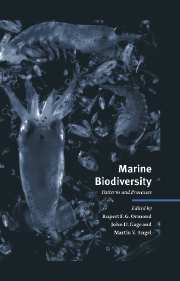Book contents
- Frontmatter
- Contents
- List of contributors
- Foreword: The value of diversity
- 1 Marine biodiversity in its global context
- 2 Gradients in marine biodiversity
- 3 Pelagic biodiversity
- 4 Biological diversity in oceanic macrozooplankton: More than counting species
- 5 Large-scale patterns of species diversity in the deep-sea benthos
- 6 Diversity, latitude and time: Patterns in the shallow sea
- 7 High benthic species diversity in deep-sea sediments: The importance of hydrodynamics
- 8 Diversity and structure of tropical Indo-Pacific benthic communities: Relation to regimes of nutrient input
- 9 Why are coral reef communities so diverse?
- 10 The biodiversity of coral reef fishes
- 11 The historical component of marine taxonomic diversity gradients
- 12 Population genetics and demography of marine species
- 13 Discovering unrecognised diversity among marine molluscs
- 14 Ecosystem function at low biodiversity – the Baltic example
- 15 Land–seascape diversity of the USA East Coast coastal zone with particular reference to estuaries
- 16 The development of mariculture and its implications for biodiversity
- 17 Protecting marine biodiversity and integrated coastal zone management
- 18 Conserving biodiversity in North-East Atlantic marine ecosystems
- Author index
- Species index
- Subject index
4 - Biological diversity in oceanic macrozooplankton: More than counting species
Published online by Cambridge University Press: 04 August 2010
- Frontmatter
- Contents
- List of contributors
- Foreword: The value of diversity
- 1 Marine biodiversity in its global context
- 2 Gradients in marine biodiversity
- 3 Pelagic biodiversity
- 4 Biological diversity in oceanic macrozooplankton: More than counting species
- 5 Large-scale patterns of species diversity in the deep-sea benthos
- 6 Diversity, latitude and time: Patterns in the shallow sea
- 7 High benthic species diversity in deep-sea sediments: The importance of hydrodynamics
- 8 Diversity and structure of tropical Indo-Pacific benthic communities: Relation to regimes of nutrient input
- 9 Why are coral reef communities so diverse?
- 10 The biodiversity of coral reef fishes
- 11 The historical component of marine taxonomic diversity gradients
- 12 Population genetics and demography of marine species
- 13 Discovering unrecognised diversity among marine molluscs
- 14 Ecosystem function at low biodiversity – the Baltic example
- 15 Land–seascape diversity of the USA East Coast coastal zone with particular reference to estuaries
- 16 The development of mariculture and its implications for biodiversity
- 17 Protecting marine biodiversity and integrated coastal zone management
- 18 Conserving biodiversity in North-East Atlantic marine ecosystems
- Author index
- Species index
- Subject index
Summary
Abstract
Pelagic systems are the largest on earth. Compared with the terrestrial habitat these systems, which are composed of taxa with vast ranges of distribution, do not show high species richness. In general species richness in pelagic animal groups decreases from lower to higher latitudes. Speciation processes seem to be slow in the ocean. However, the genetic diversity within a pelagic species might be very high because of the very large distributional ranges where geographic differences occur in environmental conditions. There might be a number of cryptic species as yet undetected.
There is a suggestion of a strong link between the general oceanic circulation and the productivity regime, and pelagic distributions in the different regions. The polar production cycle is characterised by a single peak in summer, the temperate cycle has a spring and autumn bloom and the (sub) tropical regime has relatively low continuous production with a slight peak in winter. The main abundance and biomass of Chaetognatha is in the upper 200 m of the water column and north of 40° latitude. Vertically and horizontally there seems to be an inverse relationship between productivity and biological diversity. The relationship might not be a direct one but might rather reflect regions with high mixing and regions with fewer perturbations.
Introduction
Pelagic ecosystems are the largest on earth. The oceans cover about 70% of the surface of the globe to an average depth of 4 km.
- Type
- Chapter
- Information
- Marine BiodiversityPatterns and Processes, pp. 69 - 93Publisher: Cambridge University PressPrint publication year: 1997
- 13
- Cited by



